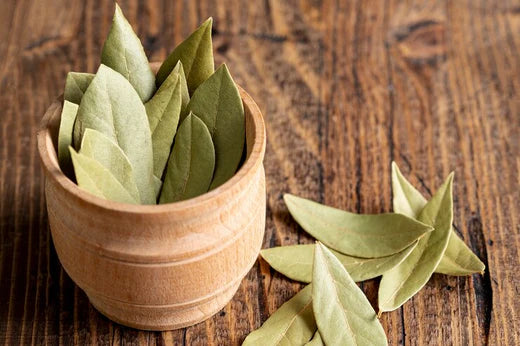(Cinnamomumtamala) is the bay leaf's scientific name. It is a little Mediterranean evergreen shrub or tree with smooth, hairless green leaves. The flavor and smell of this herb are unique. It is frequently used in cooking and is simple to find in the kitchen. Fresh leaves are relatively weak and do not fully develop their flavor compared to the fully flavorful dry leaves. This herb's leaves are utilized in dried form. This plant aids in raising the Pitta Dosha while calming the Vata and Kapha Doshas.
Bay Leaves Synonyms
- Laurel leaf
- Tejapatra
- Patraka
- Utkat
- Tamaalpatra
- Naalikaa
- Naalukaa
Regional Names of Bay leaf
Classification of Laurus nobilis
Kingdom: Plantae
Phylum: Angiosperms (vascular plants)
Class: Magnoliopsida
Order: Laurales
Family: Lauraceae
Genus: Laurus
Species: Laurus nobilis
Description of Laurus nobilis
Tejpatta is the popular name for bay leaf. Tejpatta is a little tree that grows to a height of only 20 to 30 feet. Tejpatta tree bark has folds and is rough, tough, and thin. The tree's spherical, evergreen branches are covered in leaves all year round. The leaves have a pungent scent and are thick, 4–7 inches long, with a deep vein-like structure on the upper surface. The fruit of this tree is spherical, purple in color, and contains just one seed. Flowers begin to blossom in January, and fruits start to show up in May through August.
Habitat
Although the bay leaf tree is a Mediterranean native, it is now widespread over the globe. It can be found in the Khasi Hills, Nilgiri Hills, tropical and subtropical Himalayas, as well as at the foot of the Sikkim Himalayas.
Chemical Composition
About 1.3% of the essential oils in bay leaf are composed of eucalyptol, terpinyl acetate, other terpenes, sesquiterpenes, methyl eugenol, linalool, phellandrene, geraniol, terpineol, and lauric acid.
1, 8-cineole, often known as eucalyptol, is one of Laurus nobilis essential oil's most prevalent ingredients.
Types of Bay leaf:
Bay leaves come from different plants:
- Mediterranean bay leaf: This culinary herb is frequently used to flavor soups, stews, etc.
- California bay leaf: These leaves have a greater flavor and are longer and skinnier.
- Indian bay leaf: Indian bay leaves are shorter and have one large vein along the length of the leaf. They are also a light to medium green tint. This cultivar is employed medicinally.
- Bay leaf from Indonesia: these fragrant leaves are used in Indonesian cuisine.
Ayurvedic Properties
|
|
Hindi / Sanskrit |
English |
|
Rasa (Taste) |
Madhura, Katu |
Sweet, Pungent |
|
Guna (Physical Property) |
Laghu, Tikshna, Pichila |
Light, Sharp, Slimy |
|
Virya (Potency) |
Ushna |
Hot |
|
Vipaka (Post-Digestive Taste) |
Katu |
Pungent |
Effect on Doshas
It alleviates Vata dosha and Kapha dosha due to Ushna veerya and Laghu and Tikshna qualities, respectively.
Bay leaf supports weak digestive heat and aids with Ama removal.
Action on Various Systems
Uses and Benefits
You can use the bay leaf in decoction, paste, powder, or whole-leaf form. Both internal and external uses are possible for it.
External use:
- Make a paste out of the leaves, rub it on your chest, and let it sit for the night. Similar results can be seen while inhaling the vapor, which also gets rid of the bacteria that harm the respiratory tract.
- When the bay leaves are soft, soak them in water to increase the health of your hair follicles and get rid of dandruff. Then, after showering, rub the leaves on your scalp.
- Apply the bay leaf paste to painful disorders such as migraines and headaches.
Internal use:
- The digestive tract responds quite strongly to bay leaf. It aids in the stomach's toxin removal. It also lessens the symptoms of Celiac disease and other illnesses including irritable bowel syndrome (IBS).
- The antibacterial properties of bay leaf. Bay leaf essential oil can be applied to the chest to help with a variety of respiratory conditions.
- The bay leaf aids in lowering inflammation all over the body.
- Low-density lipoprotein (bad cholesterol) is removed by the bay leaf, which is good for the cardiovascular system.
- Bay leaves enhance insulin receptor performance and support the body's control of blood sugar levels. Patients with type 2 diabetes who take it have lower levels of LDL, or "bad cholesterol," and higher levels of HDL, or "good cholesterol."
- Additionally, the antifungal qualities of bay leaf specifically combat the Candida infection. The leaf stops candida from adhering to cell walls and prevents it from penetrating through membranes.
- Because of the phytonutrients, catechins, linalool, and parthenolide found in bay leaves, our bodies are better able to fend off the effects of cancer-causing free radicals. Because bay leaves contain these antioxidants and organic substances, they may prevent the action of free radicals, which can turn healthy cells into malignant cells.
- When used as aromatherapy, the linalool found in bay leaves can help lower the body's level of stress hormones. Bay leaves help you relax even when you are experiencing high levels of worry because an increase in stress hormone levels might be detrimental.
Part Used
The bay leaf's components that are utilized to make medicine are:
- Bay Leaves
Dosage
- Leaves Churna (powder): 1-4 gm
- Oil- 2-5 drops
Easy ways to utilize Bay Leaf at Home
It has numerous uses at home, including the following:-
Caution
Tejpatra can have negative effects on your health, such as hyperacidity and mouth ulcers, if you consume it more frequently.
Ayurvedic Classical formulation
- AgnimukhChurna
- TejpatrChurna
- LavanbhaskarChurna
- Agnisandipanras
- Tavakpatraghuduartan tail
Ayurveda's Product which contains Bay Leaves as an Ingredient
- Avipattikar Churna
- Dadimashtak Churna
- Lavanbhaskar Churna
Reference
- Commentary by Padmshri on Bhavparkash Nikhantu of Sri Bhavamisra (c. 1500–1600 A.D.) KrishanchanderChunekar, Prof. (2015) page 218 of the late Dr. G.S. Pandey's edited work
- Kaviraj's Bhaishajya Ratnavaliby professor Siddhi Nandan Mishra, Govind Das Sen

